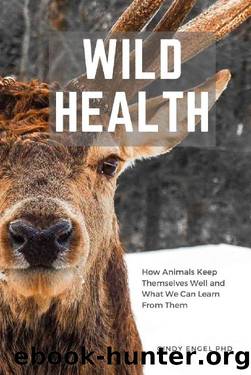Wild Health: How animals keep themselves well and what we can learn from them by Cindy Engel

Author:Cindy Engel [Engel, Cindy]
Language: eng
Format: epub
Publisher: Houghton-Mifflin
Published: 2021-01-12T05:00:00+00:00
OTHER ANIMALS SCOUR THEIR WORMS
Once physical scouring became the accepted hypothesis to explain leaf swallowing, it became clear that primates are not the only species to use this method of worm control.
At certain times in an animalâs life, such as migration and hibernation, parasites are more of a health hazard than usual. If an animal goes into hibernation with a gut full of parasites, the parasites will eat the animalâs carefully stored food reserves while it sleeps. Biologists have known for years that hibernating bears somehow get rid of internal parasites in the autumn before hibernation. When Barrie Gilbert spent six years studying Alaskan brown bears in Katmai National Park, he noticed that they changed their diet and started to eat âstrange thingsâ in the few months leading up to hibernation. Highly fibrous sharp-edged sedge (Carex spp., Cyperaceae) began to appear in large dung masses otherwise almost completely composed of long tapeworms. The coarse plant material was apparently scraping out the worms in a way similar to the rough leaves swallowed by chimpanzees. Physical expulsion seems to be used by Canadian snow geese as well. The geese carry significant tapeworm burdens in the summer, but just before migration they deposit large boluses of undigested grass and tapeworms in their dung. When they reach their migration destination, they are completely clean of tapeworms. In both brown bears and snow geese, worms are shed at a time of critical nutritional stress, a time when carrying these parasites would greatly reduce the animalâs chances of survival.26
Closer to home, domestic dogs and cats both occasionally chew grass, as every pet owner knows. The grass seems to have two effects: one is emetic (stimulating regurgitation or vomiting), the other, a purgative scour (ridding the body of worms farther down the intestine). Thus the grass could work at either end of the intestine, depending on which orifice was nearest to the problem. Herbalist Maurice Messegue claims that some dog species discriminate between different grasses for different medicinal functions, using hairy grasses for emetics and couch grass as a purgative. In Tanzania a veterinarian known to Huffman observed a dog shed roundworms by eating grass.27
Our companion cats and dogs are most likely carrying on a residual self-medication strategy of their wild ancestors. Wolves eat grass--and all year round, it seems. Biologist Adolf Murie, studying a pack on Mount McKinley, noted that grass eating seemed to act as a scour, for roundworms often came out with the grassy droppings. He watched while one particular wolf ate grass for a few minutes and then produced a watery scat. Later the same wolf vomited some of the grass he had eaten. According to Indian folklore, tigers will (on rare occasions) eat grass âwhen hungryââand if heavily infested with worms, the tigers may appear emaciated. A small portion of the droppings of wild Indian tigers has been found to consist almost entirely of grass blades, and in at least one case a tapeworm was found inside.28
Traditional herbalists have used purges and
Download
This site does not store any files on its server. We only index and link to content provided by other sites. Please contact the content providers to delete copyright contents if any and email us, we'll remove relevant links or contents immediately.
Spare by Prince Harry The Duke of Sussex(4195)
Machine Learning at Scale with H2O by Gregory Keys | David Whiting(2289)
Fairy Tale by Stephen King(2068)
Will by Will Smith(2041)
Hooked: A Dark, Contemporary Romance (Never After Series) by Emily McIntire(1957)
Rationality by Steven Pinker(1764)
The Bullet Journal Method by Ryder Carroll(1501)
The Becoming by Nora Roberts(1330)
Friends, Lovers, and the Big Terrible Thing by Matthew Perry(1327)
A Short History of War by Jeremy Black(1299)
HBR's 10 Must Reads 2022 by Harvard Business Review(1255)
The Strength In Our Scars by Bianca Sparacino(1244)
Can't Hurt Me: Master Your Mind and Defy the Odds - Clean Edition by David Goggins(1227)
515945210 by Unknown(1207)
Fear No Evil by James Patterson(1108)
Love on the Brain by Ali Hazelwood(1095)
Bewilderment by Richard Powers(1083)
This Family Does It by Kevin Sellers(1080)
443319537 by Unknown(1072)
